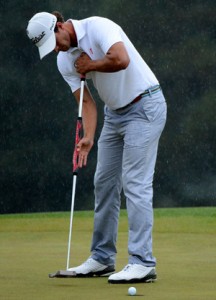The game of golf has changed drastically over the past decade and the trend continues with the banning of anchored putting which has been legal for over 30 years. Should those playing college golf with the NCCGA follow suit?There’s the consistent increase in absurdity of the driver club-head size, almost as if you hadn’t looked down and noticed you were hacking away at a little white ball, you would be uncertain as to whether you were playing golf or trying to nail down a railroad tie. The upbringing of spin-milled wedges, trampoline face irons, and the ever-changing little white ball are all ways the game has shifted into a new era.
In hindsight, such advances have become a part of the game as courses have become longer and more difficult. Putting technology has certainly improved, a large part of which concerned the creation of non-standard putters such as belly putters.
But using an atypical putter doesn’t magically put the ball in the whole explains Aaron Dooley, head golf professional at Ballyhack Golf Club:
“I don’t use the long putter…I can’t even make a decent stroke. I don’t think they should be banned though. If you look into the stats and really break it down, none of the guys using long putters are ranked in the top 50 in putting stats. The [long] putters may fix the ‘yips,’ but there clearly isn’t any advantage over the guys using the conventional putters.”
The key topic here is not whether traditionalists such as myself like the look or feel of such putters, but to make the game fair for all parties involved, both at the professional and amateur level. Matt Harman plays varsity college golf for Radford University and has been experimenting with ways to improve his putting stroke and technique since he was a youngster.
“Those guys on Tour are so darn good, they’re going to get the ball in the hole no matter what kind of putter they use,” Harman said. “Every one of those guys that use long putters have been successful at some point in their life with both long and short putters, but it’s all about what is comfortable for them and what works.”
Although four of the last six major championship winners used a long putter of some sort, can we attribute their victories to outstanding success with the flat stick?
Let’s take a look at the stats according to pgatour.com:
- Webb Simpson, winner of the 2012 U.S. Open, ranks 53rd in strokes-gained putting
- Keegan Bradley, the 2011 PGA Championship winner, ranks 55th
- Recent Masters champion, Adam Scott, ranks 80th
- The Open champion, Ernie Els, ranks 88th.
In last year’s U.S, Open, Webb Simpson didn’t “win” the championship. It was choked away by Jim Furyk’s horrendous ball striking down the stretch. Ernie Els didn’t “win” The Open, Adam Scott—also a user of the long putter, might I add—chocked it away with bogeys on the final four holes, mainly due to poor—wait for it—putting.
Adam Scott, however, bounced back to win the Masters, not because Angel Cabrera handed it to him, but because he went out and earned it. Sure, he made some big putts on the 72nd hole and on the second playoff hole, but he won at Augusta because of his exceptional ball striking and world-class short game.
Over the years, golf’s innovators have created multiple ways to help quiet the hands and help golfers become more efficient on the putting surface. If the USGA and the R&A—European golf’s governing body—bans the use of long putters, where will they stop? Do they do away with the way players are allowed to grip the club, considering some grips are more effective for different players? What do you tell the college golf players who use the belly putter because they suffer from back pain?
Although some may view nonconventional putters as an unfair advantage, I struggle to understand how it is unfair. All players should have the equal right and opportunity to use any putter. There is a reason why all of the top 50 putters in the world use conventional putters—because it works for them. Bob Harig, senior golf writer for ESPN.com, has covered the game for 20 years and noted that in the end, “you still have to read the putt and hit it the correct speed.” Harig’s ideology is much like the saying from Francis Ouimet’s wise, 10-year-old caddy, Eddie Lowery: “Read it, roll it, hole it.”
Need help recruiting for your golf team?
Though it may be easier said than done, reading a putt, rolling it, and holing it still remains an art that very few master in their lifetime. As a traditionalist of the game, I originally evoked hatred to the odd-looking clubs and I do not intend on adopting the “gut-poker” anytime soon, but until the best putters in the world are crowded by users of the belly putter, I find it difficult to appoint one player with an advantage over another. Using “sticks” that are longer than most drivers on the green may seem a bit unorthodox, but as long as it doesn’t provide professionals with an unfair advantage, it’s all golf to me.
**Connect with the NCCGA on Twitter @NCCGA and tell us what you think!





